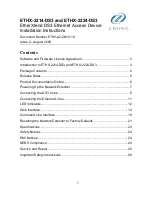
928
Configuring IPv6 Unicast Routing
Information About IPv6
For easier implementation, leading zeros in each field are optional. This is the same address without leading zeros:
2031:0:130F:0:0:9C0:80F:130B
You can also use two colons (::) to represent successive hexadecimal fields of zeros, but you can use this short version
only once in each address:
2031:0:130F::09C0:080F:130B
For more information about IPv6 address formats, address types, and the IPv6 packet header, see
Basic Connectivity Configuration Guide, Cisco IOS Release 15M&T
in the
IPv6 Configuration Library, Cisco IOS Release
In the “Information About Implementing Basic Connectivity for IPv6” chapter, these sections apply to the switch:
IPv6 Address Formats
IPv6 Address Type: Unicast
IPv6 Address Output Display
Simplified IPv6 Packet Header
Supported IPv6 Unicast Routing Features
Support on the switch includes expanded address capability, header format simplification, improved support of
extensions and options, and hardware parsing of the extension header. The switch supports hop-by-hop extension
header packets, which are routed or bridged in software.
The switch provides IPv6 routing capability over 802.1Q trunk ports for static routes, Routing Information Protocol (RIP)
for IPv6, and Open Shortest Path First (OSPF) Version 3 Protocol. It supports up to 16 equal-cost routes and can
simultaneously forward IPv4 and IPv6 frames at line rate.
Note:
For more information about the IPv6 unicast routing features described in this section, see
Library, Cisco IOS Release 15M&T
IPv6 Implementation Guide, Cisco IOS Release 15.2M&T
128-Bit Unicast Addresses, page 929
Path MTU Discovery for IPv6 Unicast, page 929
Default Router Preference, page 930
IPv6 Stateless Autoconfiguration and Duplicate Address Detection, page 930
Dual IPv4 and IPv6 Protocol Stacks, page 930
DHCP for IPv6 Address Assignment, page 931
Static Routes for IPv6, page 931
Summary of Contents for IE 4000
Page 12: ...8 Configuration Overview Default Settings After Initial Switch Configuration ...
Page 52: ...48 Configuring Interfaces Monitoring and Maintaining the Interfaces ...
Page 108: ...104 Configuring Switch Clusters Additional References ...
Page 128: ...124 Performing Switch Administration Additional References ...
Page 130: ...126 Configuring PTP ...
Page 140: ...136 Configuring CIP Additional References ...
Page 146: ...142 Configuring SDM Templates Configuration Examples for Configuring SDM Templates ...
Page 192: ...188 Configuring Switch Based Authentication Additional References ...
Page 244: ...240 Configuring IEEE 802 1x Port Based Authentication Additional References ...
Page 298: ...294 Configuring VLANs Additional References ...
Page 336: ...332 Configuring STP Additional References ...
Page 408: ...404 Configuring DHCP Additional References ...
Page 450: ...446 Configuring IGMP Snooping and MVR Additional References ...
Page 490: ...486 Configuring SPAN and RSPAN Additional References ...
Page 502: ...498 Configuring Layer 2 NAT ...
Page 770: ...766 Configuring IPv6 MLD Snooping Related Documents ...
Page 930: ...926 Configuring IP Unicast Routing Related Documents ...
Page 976: ...972 Configuring Cisco IOS IP SLAs Operations Additional References ...
Page 978: ...974 Dying Gasp ...
Page 990: ...986 Configuring Enhanced Object Tracking Monitoring Enhanced Object Tracking ...
Page 994: ...990 Configuring MODBUS TCP Displaying MODBUS TCP Information ...
Page 996: ...992 Ethernet CFM ...
Page 1066: ...1062 Using an SD Card SD Card Alarms ...
















































